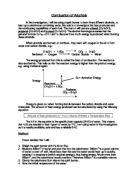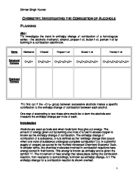Alcohols are very flammable, so I will position my apparatus appropriately, keeping safety in mind, to ensure that other students or myself are not hurt. Therefore, all fuels must be kept away from naked flames. Safety goggles must be worn throughout the investigation. All spirit burners must be kept away from any books. Once the test has finished the water in the calorimeter and the calorimeter itself will be very hot, so it must be left to cool for about two minutes.
Apparatus
Calorimeter, thermometer, stirrer, clamps (to hold the calorimeter (not illustrated below)), a spirit burner and a digital balance.
Variables
-
Volume of Water in Calorimeter – If I use too much water, it will take too long for it all to heat up and as only some of the water will heat slowly, any reading on the thermometer would be very inaccurate. Too little water and most of the heat energy will go into heating the calorimeter. The temperature would also rise too rapidly causing the water to evaporate, which requires a lot of energy. Therefore, I will use 200cm3 to start with.
-
Type of Calorimeter – I will use a copper calorimeter throughout the investigation because the transfer of heat into the water will happen quickly, but because the conductivity of the copper is so good, that heat will be lost into the air quickly also. A glass calorimeter would retain the heat before transferring it to the water. This would take up too much time. Therefore, I will use a copper calorimeter for it will transfer heat quickly.
-
Carbon Soot – If left on the bottom of the calorimeter, it will act as an insulator and slow down the rate of heat transfer to the container and the water. Therefore, it must be wiped off the bottom of the calorimeter.
-
Distance Between Bunsen and Calorimeter – I will keep the distance between the Bunsen Burner and the calorimeter at 5cm. If it were less, the temperature would rise but incomplete combustion would occur rapidly. If it were higher, the temperature would rise too slowly and the hot air from the flame would be more vulnerable to drafts.
-
Temperature Increase Being Measured –50°C is a good temperature rise as it will make my calculations later on, easier. As I explained earlier, a higher temperature rise will cause evaporation of the water to occur, which requires a lot of energy. Therefore, 50°C is a good temperature rise to start with. I will later change this to 25°C.
-
Fuel Being Used – This is the independent variable. I have to use one alcohol to keep the test a fair one, this is because all alcohols burn differently and produce different amounts of heat. In this investigation, I will use Ethanol.
Breaking Bonds
I predict that the larger the molecule, the more energy will be required to break its bonds, therefore the more heat produced. This is because large molecules have many bonds, but small molecules have few bonds. I can demonstrate this by working out the theoretical heat of combustion of the three alcohols by using the following tables and equation:
ΔH = Bonds Broken – Bonds Formed
Combustion of Ethanol
C2H5OH + 3O2 2CO2 + 3H2O
Energy
Combustion of Propanol
C3H7OH + 4½O2 3CO2 + 4H2O
Energy
Combustion of Butanol
C4H9OH + 6O2 4CO2 + 5H2O
Energy
This proves my theory in which the longer the molecular structure of an alcohol, the more energy is required to break all the bonds. Therefore, the longer the molecules, the more heat is given off.
The values I calculated are different from those in the text book because the text book values are calculated differently. However, I believe the text book values are more reliable.
I predict that my practical values will be lower than both my calculated values and the text book values. This is due to the following reasons:
- The calorimeter takes in a lot of the heat energy, which is why it gets hot.
- Energy from the flame given off as light energy.
- Draft would move a lot of heat away from the calorimeter.
- Water in the calorimeter was at different temperatures in different places.
- The higher the temperature of the calorimeter, the faster the heat loss due to the lower temperatures outside the calorimeter.
- Incomplete combustion occurred. This can be detected by the carbon soot forming on the underside of the calorimeter.
Practical Work
In the following three tests I conducted, the fuel I used was ethanol and I calculated the heat produced by using the equation on the first page. I have typed it out once again:
Heat Produced = 4.2 x V x T
V = Volume of water (cm3)
T = Temperature rise
To calculate the amount of heat per mole, I used the following equation:
Heat per Mole = 4.2 x V x T
N
N = number of moles
= mass of fuel
46 (46 = Mr of ethanol)
Test 1.
Variable changed = none
- Initial weight of spirit burner = 196.97g
-
Volume of water in calorimeter = 200cm3
- Initial temperature of water = 22°C
- Height of calorimeter above spirit burner = 5cm
- Desired temperature increase = 50°C
- Final weight of burner = 192.59g
- Mass of fuel used = 4.38g
Heat produced = 4.2 x 200 x 50 = 42kJ
Number of moles of fuel = 4.38 = 0.1M (2.d.p.)
46
Heat per mole = 42 = 420kJ
0.1
Test 2.
Variable changed = volume of water in calorimeter
- Initial weight of spirit burner = 192.59g
-
Volume of water in calorimeter = 150cm3
-
Initial temperature of water = 22°C
- Height of calorimeter above spirit burner = 5cm
- Desired temperature increase = 50°C
- Final weight of burner = 188.38g
Heat produced = 4.2 x 150 x 50 = 31.5kJ
Number of moles of fuel = 4.21 = 0.09M (2 d.p.)
46
Heat per mole = 31.5 = 350kJ
0.09
Test 3.
Variable changed = Desired temperature rise
- Initial weight of spirit burner = 188.38
-
Volume of water in calorimeter = 200cm3
- Initial temperature of water = 22°C
- Height of calorimeter above spirit burner = 5cm
- Desired temperature increase = 25°C
- Final weight of burner = 185.95g
- Mass of fuel used = 2.43g
Heat produced = 4.2 x 200 x 25 = 21kJ
Number of moles of fuel = 2.43 = 0.05M (2 d.p.)
46
Heat per mole = 21 = 420 kJ
0.05
The results from these tests can be tabulated for easier reference:
If I had more time, I would have conducted more tests and changed different variables. I have noticed a couple of things:
1. By halving the desired temperature rise, I halved the heat produced; however, the heat per mole is not altered.
2. By taking a quarter of the volume of water off (200cm3 - ¼ x 200cm3 = 150cm3), a quarter of the heat produced is taken off (42 kJ - ¼ x 42 kJ = 31.5 kJ). However, a quarter of the heat per mole value is not removed from itself.
Therefore, whatever you do to a variable, i.e. if you double it, halve it, square it, etc. you do to the same amount of heat produced.
My results are lower than those found in the text books because the fuel burned with a yellow flame and carbon soot was deposited on the bottom of the calorimeter. This indicates that incomplete combustion had taken place. Therefore, the fuel was not burning fully, and as a consequence, less heat energy was produced.
I can draw a table to show the percentage of heat energy given out to heat the water:







